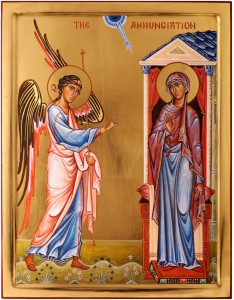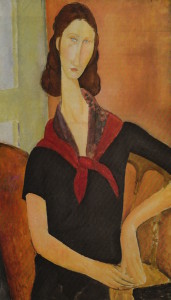
Just read an amazing (but very long) article in The Orthodox Arts Journal:
“The Altar and The Portico (pt. 2): Gallery Art” by Aidan Hart. Subtitles tell more: THE SACRED AND THE SECULAR… The Relationship of Orthodox Iconography and Gallery Art.
Hart was a secular artist before becoming Orthodox and pursuing iconography. He worked as a sculptor within the Anglican/Episcopal church. Here’s a bit about what was driving him:
As a Christian I wanted this spirituality to embrace the material world, not to be a flight from it. I felt that this incarnational approach was all the more important in a secular age which worshipped matter and where one could not assume any prior knowledge of Christianity.

Hart’s move towards iconography mirrors some of my own interests, although his was on a professional level:
To abstract means literally to “draw out”, and in its original meaning it denotes the discovery and manifestation of the essence of the subject, and not departure from reality as it tends to be understood today.
The art most influential for me at this stage was Egyptian and African work. Although perhaps too disembodied, too extreme in their abstraction, these sculptures helped me to reach some conclusions about how to indicate the spiritual. Most notably I learned the importance of a strong vertical axis or elongation; stillness rather than agitated movement; and emphasis on the eyes. Constantine Brancusi and Modigliani were also influences.
I’ve always been a fan of abstract art. I’ve never thought about why I like Modigliani so much, but I also liked his work before I studied iconography. Hart eventually visited some Orthodox monks in New Zealand—one of who was an iconographer—and found what he had been searching for. He became Orthodox in 1983 and began writing icons. And then he began to wonder how spiritual art could find a place in galleries:
For me personally there are two types of artwork that do this: that which depicts suffering but with compassion, and that which suggests the world transfigured by light…. So first, compassionate art. Such works can help us see the divine image beneath suffering, and even behind ignorant acts. They show us that what makes us capable of suffering is also what makes us human.
Then he writes about the world transfigured by light:
Another form of threshold art is the art of illumination. Ascetic writers both East and West describe three stages in the spiritual life: purification, illumination and union… Icons indicate this luminous grace symbolically by such things as gold lines on trees, furniture and garments, and of course also haloes and golden backgrounds.
I’ve only touched on the treasures in this article, so I hope that if you’re interested in art and/or spirituality, you’ll give it a read. There are also lots of terrific illustrations of Hart’s work in the article. Enjoy!